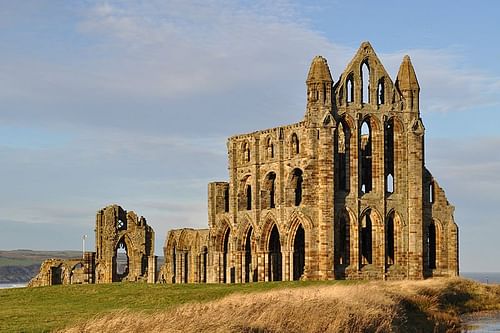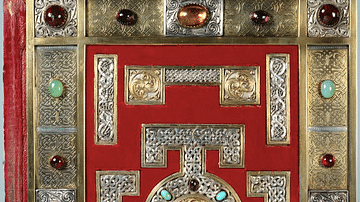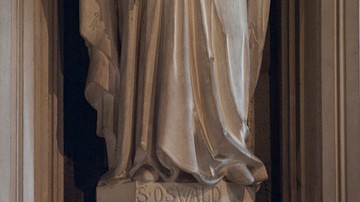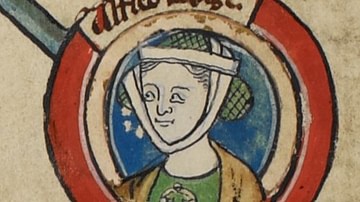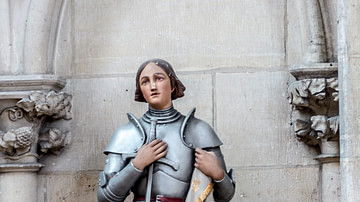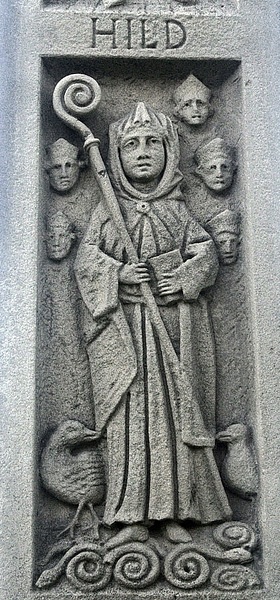
Hilda of Whitby (also known as Saint Hilda of Whitby, l. 614-680 CE) was the founder and abbess of the monastery at Whitby, Kingdom of Northumbria, Britain. She was a Northumbrian princess who converted to Christianity with the rest of the court of her great-uncle, King Edwin of Deira (r. 616-633 CE), when she was 13. She was raised at Edwin's court in the tradition of Roman Catholicism, but at the age of 33 became an adherent of Celtic Christianity, tutored in the faith by Aidan of the monastery of Lindisfarne, and was abbess at Hartlepool Abbey before founding the monastery at Whitby.
She was highly educated and her wisdom was so legendary that her counsel was sought by nobility and commoners alike. Hilda was an able administrator, carefully overseeing the large estate of Whitby while also ministering to the needs of the community. She encouraged the shepherd Caedmon to share the famous hymn which came to him in a vision (Caedmon's Hymn, 7th century CE), the oldest extant poem in Old English, for which she is honored as patron saint of poetry in addition to her honor as patron saint of culture, literacy, and learning.
She hosted and presided over the Synod of Whitby in 664 CE which decided whether the traditions of Celtic or Roman Christianity would be adhered to in Britain and, even when the vote went against her side, stood beside the Church's decision and encouraged unity of vision in adhering to Roman tradition. Her story and Caedmon's Hymn is first recorded by Bede (l. 673-735 CE) in his Ecclesiastical History of the English People (published 731 CE). Hilda's virtuous life, wisdom, and unceasing care for others, no matter their social status, led to her veneration shortly after her death.
Northumbria & Early Life
The Kingdom of Northumbria (c. 604-954 CE) was originally divided between two separate, and hostile, political entities: Bernicia in the north and Deira in the south. These two were in continuous conflict until they were united in 604 CE under the reign of the king Aethelfrith (r. 593-616 CE) of Bernicia.
When Aethelfrith united the kingdoms, he disinherited the ruling house of Deira and drove the Deiran nobility, including Prince Edwin and his nephew Hereric, into exile. Hereric went to the Brittonic kingdom of Elmet (in present-day West Yorkshire) where he and his wife Breguswith had two daughters, Hereswith and Hilda. Hereric was poisoned while at the Elmet court and, after his death, the infant Hilda and her older sister were taken under the care of Edwin who was in exile in East Anglia.
When Aethelfrith died in 616 CE, Edwin returned and claimed the throne, ruling from Deira. Hereswith and Hilda were raised at Edwin's court. The peace established by Aethelfrith was threatened under Edwin by the Kingdom of Mercia at its border and the southern Kingdom of Wessex. In 626 CE, Cwichelm of Wessex (d. 636 CE) sent an assassin to kill Edwin but the plot was foiled and credit was given to the Christian god. Previously, the nobility of Northumbria was pagan but, in gratitude for his life, Edwin – and his entire court including Hilda – converted to Christianity in 627 CE.
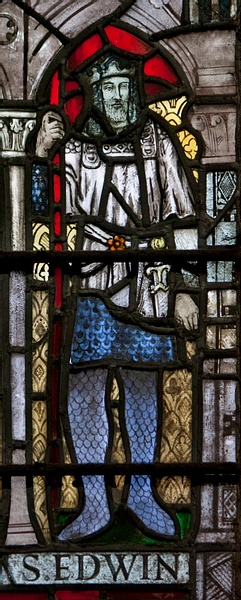
Edwin had been victorious over the combined forces of Wessex and Mercia in late 626 CE at the Battle of Win-and-Lose Hill but King Penda of Mercia (r. c. 625-655 CE) turned on his allies, defeated them, and then struck at Northumbria. In 633 CE, Penda defeated the Northumbrians at the Battle of Hatfield Chase in which Edwin and his son Osfrith were both killed. Northumbria's power collapsed and Hilda fled with her mother and sister to Kent. Edwin was succeeded by Oswald (r. 634-642 CE), who devoted himself to turning his people from the religious errors of Roman Catholicism to what he viewed as the self-evident truth of Celtic Christianity.
Celtic Christianity, Education, Return to Northumbria
Oswald was a champion of the tradition now known as Celtic Christianity (what it was called at the time is unclear). What 'Celtic' Christianity entailed is unknown other than that the Celtic Christian monks were tonsured (hair was cut) differently from Roman Catholic monks and Celtic Christians celebrated Easter on a different date than Roman Christians (Catholics).
Oswald considered the Roman Catholic tradition a grave error and so appointed the Irish monk Aidan (later Saint Aidan, d. 651 CE), a Celtic Christian, as missionary to his people to bring them back to the ways of truth. Aidan began by building the monastery at Lindisfarne. What Hilda was doing during this time is unclear but she must have been associated in some way with a religious order because c. 647 CE, when she was 33 years old, she answered Aidan's call to return to Northumbria and establish a convent which she set up somewhere along the north bank of the River Wear.
By this time she was already well educated as evidenced by her apparent literacy in corresponding with Aidan. Scholar Eileen Power notes:
There were several, at least four, different ways in which the women of the Middle ages were able to acquire literary education: by instruction in schools in nunneries for the gentry and the better class of bourgeoisie; by being sent to the households of great ladies where they could learn breeding and no doubt acquire some intellectual attainments; by technical and general education provided by apprentice-ship or the bourgeois equivalent of the above, available for girls of craftsmen class in towns; by elementary schooling for girls of poorer classes in town and country. (80)
Under normal circumstances, Hilda would have been educated at court by the finest teachers – and perhaps this was so at Edwin's court and later in Kent – but this is unknown. The court of Northumbria was far from stable during Hilda's youth and East Anglia's was hardly more so. Bede notes that her sister Hereswith was educated at a nunnery, and this may have been the same for Hilda. However she received her education, she would become widely respected for it.
Hilda had been raised in the tradition of Roman Catholicism at Edwin's court but now, under Aidan's supervision, was instructed in Celtic Christianity which she followed obediently and taught to others. C. 649 CE, Aidan appointed her Abbess of Hartlepool Abbey which she presided over with a devotion to justice, encouraging her community's recognition and celebration of divine love, peace, and harmony.
Abbess of Whitby
In 642 CE, Oswald was killed by the Mercians in the Battle of Maserfield and Northumbria was divided between his brother Oswiu (r. 642-670 CE) who ruled Bernicia and Oswine, Edwin's cousin, who ruled Deira. Oswiu declared war on Oswine and killed him in 654 CE and then defeated and killed King Penda of Mercia in 655 CE at the Battle of the Winwaed. Prior to this battle, Oswiu is said to have prayed for victory and promised God that, if he should win, he would dedicate lands throughout Northumbria for the establishment of religious communities.
While Oswiu was stabilizing Northumbria, Hilda was gaining a reputation for virtue and wisdom at her Hartlepool Abbey. Oswiu dedicated his young daughter Aelflaed (later Saint Aelflaed, l. 654-714 CE) to Hilda to raise as a nun. In 657 CE, Oswiu granted Hilda 1200 acres of land in the Northumbrian locale of Streneshalc (in present-day North Yorkshire) where she founded her famous monastery of Whitby. The name 'Whitby' (meaning “white town”) would only become attached to the place in the 12th century CE following the Viking invasions.
The Abbey of Whitby observed the traditions of Celtic Christianity with a double monastery in which monks and nuns lived separately but worshiped together. Hilda dedicated herself to making Whitby an intellectual as well as a religious center, building a library and encouraging literacy. She not only supervised and administrated the daily operations of the enormous estate but also ministered to those living there and received visitors who came to her for counsel. Scholars Frances and Joseph Gies comment:
Seventh-century England pioneered the double monastery, with communities of both monks and nuns. The superior was invariably a woman, leading to modern speculation that the house was essentially a nunnery and that the male element was present to perform male services – manual labor, the celebration of mass, and hearing confessions. Most famous of these double monasteries was Whitby, founded by a Northumbrian princess named Hilda and known for its educational work, training, during Hilda's lifetime, no fewer than five bishops. (66)
Under Hilda's supervision and guidance, Whitby became a formidable center of learning and piety, second only to Lindisfarne, and Hilda's reputation for wisdom and justice was widely acknowledged. As Northumbria under Oswiu stabilized and prospered, attention was drawn to the persistent problem of which Christian tradition the crown should declare for as the state religion – Celtic or Roman – and Oswiu chose Hilda's monastery as the site for the conference which would decide future religious traditions and observances.
The Synod of Whitby
The pressing problem was the accepted date for Easter which the Church wanted to be uniform in all dioceses and parishes everywhere in the world. Differing dates cast doubt on the authenticity of the event Easter was supposed to celebrate but also made celebrating the event communally difficult – as when Celtic missionaries came to Rome – as long as certain clergy clung to one date while others another.
This was not a new problem for the Church. A uniform date for the celebration of Easter had been eluding Christian theologians for centuries because no one knew when precisely Jesus Christ had been born and so no one could accurately date when he had died and been resurrected.
Constantine the Great had argued for a uniform date for Easter at the Council of Nicea in 325 CE, but no one had been able to resolve the problem. The monk Dionysius Exiguus (l. c. 470-544 CE) was finally tasked with working out the date for Easter and, in so doing, invented the concept of Anno Domini (“in the year of our Lord”) and the BC/AD dating system still observed by so many in the present day. He did not actually calculate the date of Jesus' birth, death, or resurrection but estimated it based on scripture and the Roman histories he had to work with. It is for this reason that the BC/AD system is inaccurate in that it purports to date events precisely when, actually, it can only date generally.
Pressure had been put upon clerics by Pope Gregory I (served 590-604 CE) to unite the churches on a single date for Easter in order to prevent schisms and confusion and allow for communal celebration of Easter by all Christians. Priests coming to Rome from Britain, Scotland, and Ireland continued to observe the Celtic Christian customs encouraged by St. Columba (l. 521-597 CE), founder of the famous Christian community of Iona and missionary to Scotland, while those at Rome adhered to the traditions instituted by St. Peter of biblical fame.
The monk Aidan had followed St. Columba's Celtic tradition at Lindisfarne while the monks presiding over other famous centers in Britain, such as Canterbury, observed the Roman tradition. Oswiu himself favored Celtic Christianity but, politically, needed the support of both the Celtic Christians of Northumbria and the Roman Christians on the continent. He agreed to listen to the arguments for both sides objectively at the conference and then make an informed decision. Scholar Margaret Deanesly describes the event:
In 664, Oswiu convened a joint synod of clerks and it was held in the great double monastery of Streoneschalch (the later Whitby), ruled by the abbess Hilda, a place only second to Lindisfarne in the training of future bishops and abbots. The questions at variance were debated by either side before the king and Oswiu decided to range himself under the banner of Peter rather than Columba. As a result, intercourse between the English and continental churches was easier; the Celtic tribal, monastic episcopate was replaced by the continental, territorial one. (48)
Oswiu managed to sidestep confrontation with the Celtic Christians by pointing to the scriptures for validation of his decision since the Bible reports that Jesus gave Peter the “keys to the kingdom of heaven” and so Peter's vision for the Church must supersede that of the later Columba. Hilda, always a staunch supporter of Celtic Christianity since her tutelage under Aidan, had argued her cause strenuously against the Romanist priest Wilfrid of Canterbury but, once the decision was made by the king, she agreed to abide by the ruling and remained true to her word, reorganizing Whitby to conform to Roman tradition.
Death & Veneration
Hilda returned to her usual activities with her famous zeal and energy and continued to receive visits from the rich and poor, landed nobility and peasant, all of whom regarded her as their spiritual authority and trusted counselor. Hilda was regularly referred to as 'mother' by people of all social classes. The library she stocked at Whitby, according to Bede, was among the best in Britain and attracted a number of intellectuals who would train there to become abbots and bishops.
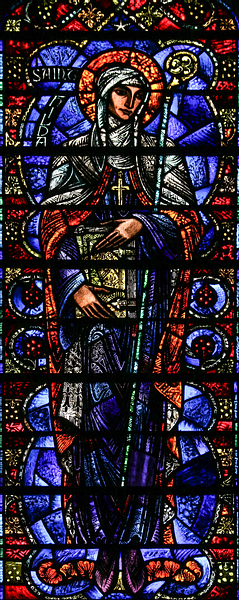
From c. 673 CE, Hilda suffered from an unknown ailment which manifested itself in fever and weakness. She refused to allow her physical condition to interfere with her responsibilities, however, and she continued on doing as she always had. In 679 CE, she founded a convent 13 miles (21 km) away from Whitby at Hackness and oversaw its development until her health failed and she died at Whitby in 680 CE at the age of 66.
According to legend, at the moment of her death the bells at Hackness rang by themselves, and the night before a nun there named Begu received a vision of angels carrying Hilda's soul to heaven; a vision shared by a nun at Whitby at the same time. She was already regarded as a saint by the early 8th century CE as more miraculous events were attributed to her and to her memory. Sea birds were said to avoid flying over the monastery of Whitby in honor of her and, if they chanced to do so, would dip their wings in respect.
Conclusion
Hilda was buried at Whitby, and her protégé Aelflaed, daughter of Oswiu, became abbess in her place. Aelflaed followed Hilda's example so closely that she too would later be sainted. The Abbey of Whitby continued to thrive until the 9th century CE. In 793 CE, the Vikings raided and sacked Lindisfarne, and these raids would continue to plague Northumbria throughout the next century. The Danes invaded Northumbria with their Great Heathen Army in 866 CE, and the abbey was raided and sacked in 867 CE and destroyed in 870 CE.
Hilda's relics were saved from the destruction and brought to Glastonbury and Gloucester. The monastery was rebuilt in 1078 CE, with Hilda's relics returning, but was destroyed by Henry VIII (r. 1509-1547 CE) during the Reformation as part of his famous dissolution of the monasteries. Hilda's name continued to be honored, however, and in the present day both Catholic and Anglican traditions revere her memory and her example of a life lived in simplicity and selflessness, finding the greatest reward in service to others.
